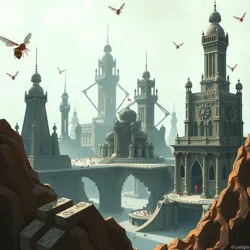Ant Empires
The Ant Empires represent a pinnacle of societal and architectural development among sentient insect civilizations that evolved after the collapse of human society. These empires are renowned for their intricate social systems, engineering feats, and strategic acumen, which have allowed them to exert significant influence across the arthropod world.

Image: The towering structures of the Ant Empires, showcasing their architectural achievements.
Historical Background
The rise of the Ant Empires can be traced back to the post-apocalyptic era when climate change and nuclear conflict decimated human populations. As environments transformed, ants adapted swiftly, utilizing their cooperative nature to survive and thrive. Initial settlements were established in resource-rich areas, gradually expanding into a vast network of interconnected colonies.
Social Structure
Ant society is characterized by a rigid caste system, with roles ranging from workers and soldiers to the highly revered queens. This organization facilitates efficient resource management and large-scale construction projects. Each colony functions as a self-sustaining unit, with its members performing specialized tasks that contribute to the collective well-being.
Architectural Achievements
The architectural prowess of the Ant Empires is evident in their towering mounds and subterranean cities. These structures are marvels of engineering, incorporating ventilation systems, water storage, and extensive food storage facilities. The most notable of these is the Great Ant Citadel, a sprawling metropolis renowned for its complexity and beauty.
Alliances and Rivalries
Throughout history, the Ant Empires have formed alliances with other species, such as the Dragonfly Nomads, while maintaining rivalries with others, such as the Spider Weavers. These relationships are often dictated by resource availability and territorial disputes, leading to both cooperative ventures and conflicts.
The Ant Empires have also played a crucial role in the formation of the Arthropod Union, a coalition aimed at addressing common challenges such as climate adaptation and resource distribution. Their diplomatic skills have been instrumental in fostering interspecies cooperation and peace.
Technological Innovations
One of the key factors behind the success of the Ant Empires is their ability to innovate. They have developed advanced farming techniques, including the cultivation of fungi, which provides a sustainable food source for their vast populations. Additionally, their mastery of pheromone communication allows for precise coordination over large distances, enhancing their military and logistical capabilities.
Cultural Impact
The cultural influence of the Ant Empires is seen in various aspects of arthropod society. Their emphasis on community and cooperation has inspired philosophical movements among the Moth Sages and artistic expressions within the Beetle Artisans. The annual Ant Festival, celebrating unity and prosperity, is a testament to their cultural legacy.
See Also
- Dragonfly Nomads
- Spider Weavers
- Moth Sages
- Beetle Artisans
- Arthropod Union
References
- The Arthropod Chronicles: "The Rise and Influence of the Ant Empires"
- "The Architectural Wonders of the Ants" in Arthropod Engineering Journal
- Diplomatic Records of the Arthropod Union: "Ants and Their Allies"
The Ant Empires continue to shape the arthropod world through their innovations, cultural contributions, and strategic alliances, ensuring their legacy for future generations.